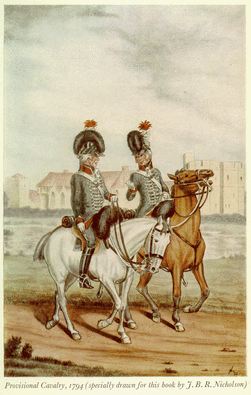During the Great War against France, the auxiliary forces of this nation were sanctioned by a constant flurry of legislation, often conflicting, that created or augmented militia, supplementary militia, local militia, fencibles, volunteers, armed associations, yeomanry and provisional cavalry, not to mention the army of the reserve and a proposed levée en masse. Of these the Provisional Cavalry must rank among the least successful.
Under the Provisional Cavalry Act of 1796 anyone who owned ten or more horses was required to provide one man on a horse for the county’s regiment; those owning fewer were grouped to the same purpose. Not surprisingly this measure proved less than hugely popular, and the following year an exemption was granted to any county whose yeomanry cavalry had reached three quarters of its provisional cavalry quota. Given the popularity of yeomanry service among the rural squirearchy and their farmers, and the exemption granted to volunteers from the provisional cavalry levy, in many counties the provisional cavalry was never embodied or soon disbanded.

Yeomanry historians who mention their county’s provisional cavalry regiment sometimes suggest that its uniform is a mystery, but in fact a prescribed dress for the whole force was devised by government and adopted where required. It was cheap, cheerful and dark green, consisting of:
“Green jacket, faced with scarlet, and corded white, price 19s; green cloth pantaloons, 10s; leather cap and feather, 2s. 6d.; half-boots, 18s.”
A total of £2 9s 6d, compared with the four pounds estimated for the provisional cavalryman’s horse furniture. The records of a number of counties indicate that these patterns were adhered to at this price, though a Shropshire reference gives the pantaloons as “feathered red”, while the Staffordshire lieutenancy appears to have undercut the cost of a Tarleton “leather cap” by opting for a “round hat looped up on one side with a green feather.”
I’m not aware of any contemporary image of a provisional cavalry trooper, but Gladstone’s history of the Shropshire Yeomanry includes a much later plate purporting to show two such (above). The turban is shown as black, the feather as red over white, the facings and red turnbacks as edged in white, with a narrow white stripe (not red as recorded) to the pantaloons. How far this is accurate to any period image or to the detail of the government pattern, I’m uncertain. (The 1969 Blandford Cavalry Uniforms by the Wilkinson-Lathams includes a plate clearly based on this, but manages to introduce a number of random discrepancies.)
For the dress of officers, we have, naturally, a little more evidence, though details here must have been shaped by the preferences of the wearer and his tailor.

A fine officer’s helmet of the Lancashire Provisional Cavalry in the National Army Museum (shown here) has a red turban, but has no surviving plume. It flaunts the county distinction of the Prince of Wales’s feathers, as do the Cheshire officers’ helmets (likewise with red turbans and plumes not visible) shown in portraits at Tabley House of Sir John Leicester (above, allegedly by Reynolds) and Ralph Leycester (below), dressed in differing silver braided versions of the uniform. (A high res image of a mezzotint of the Leicester portrait that may help to clarify details can be found here.)

In the Welch and Stalker tailor’s book at the Victoria and Albert are patterns for officers of the Dorset and North Devon regiments. The drawing for the former can be seen here on Ben Townsend’s site. A distinct regimental variation “as made for Coll. Williams & the Earl of Strafford”, this jacket of “S[uper] fine Boteille Green Cloth” is edged and trimmed in silver cord, with plated chain epaulets.
There will be other examples that I’m not aware of, but the few shown here should be enough to dispel any misconception that the Provisional Cavalry was either non-uniformed or heterogeneous, no matter how misconceived it may have been as a military initiative.
































